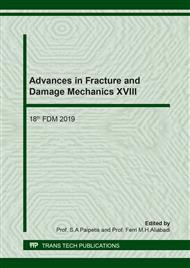p.61
p.67
p.73
p.79
p.85
p.92
p.98
p.104
p.110
Crack Tip Stress Field Analysis of Crack Surface Contact and Opening during In Situ Wedge Loading of Human Enamel
Abstract:
Shallow cracks are often observed in dental enamel, however do not normally lead to deep fractures. Previous work has highlighted the toughening mechanisms that operate in enamel during crack propagation, but very little is known about the deformation and stress fields arising around the propagating cracks during realistic loading conditions. This work aims to elucidate how the stresses are distributed within human dental enamel when a pre-existing crack is subjected to opening and surface contact with in situ indentation. We present a synchrotron-based in situ analysis coupled with a linear elastic finite element method simulation. The experimental reconstructed stress fields identified a prominent residual stress within the enamel, accompanied by a visible pattern that appeared clearly associated with its underlying microstructure. The numerical modelling of the stress field and discerning of surface contact and crack opening caused by the indentation was subsequently possible, even if in this study the influence of the anisotropy induced by the presence of features at a smaller scale was neglected. The implications of these findings and directions for future research are discussed.
Info:
Periodical:
Pages:
85-91
Citation:
Online since:
December 2019
Keywords:
Price:
Сopyright:
© 2020 Trans Tech Publications Ltd. All Rights Reserved
Share:
Citation:


